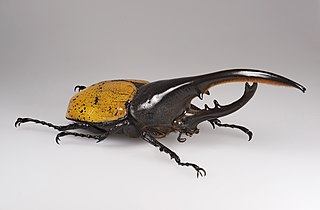
The Hercules beetle is a species of rhinoceros beetle native to the rainforests of southern Mexico, Central America, South America, and the Lesser Antilles. It is the longest extant species of beetle in the world, and is also one of the largest flying insects in the world.

The noble chafer is a species of beetles belonging to the family Scarabaeidae, subfamily Cetoniinae.

Dynastinae or rhinoceros beetles are a subfamily of the scarab beetle family (Scarabaeidae). Other common names – some for particular groups of rhinoceros beetles – include Hercules beetles, unicorn beetles or horn beetles. Over 1,500 species and 225 genera of rhinoceros beetles are known.

Dynastes tityus, the eastern Hercules beetle, is a species of rhinoceros beetle native to the Eastern United States. The adult's elytra are green, gray or tan, with black markings, and the whole animal, including the male's horns, may reach 60 mm (2.4 in) in length. The larvae feed on decaying wood from various trees.
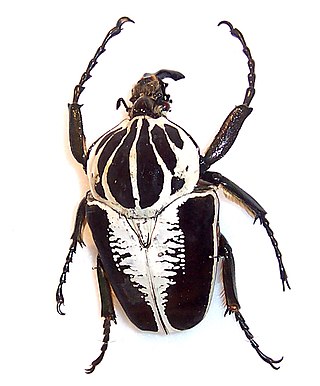
The Goliath beetles are any of the five species in the genus Goliathus. Goliath beetles are among the largest insects on Earth, if measured in terms of size, bulk and weight. They are members of subfamily Cetoniinae, within the family Scarabaeidae. Goliath beetles can be found in many of Africa's tropical forests, where they feed primarily on tree sap and fruit. Little appears to be known of the larval cycle in the wild, but in captivity, Goliathus beetles have been successfully reared from egg to adult using protein-rich foods such as commercial cat and dog food. Goliath beetles measure from 60–110 millimetres (2.4–4.3 in) for males and 50–80 millimetres (2.0–3.1 in) for females, as adults, and can reach weights of up to 80–100 grams (2.8–3.5 oz) in the larval stage, though the adults are only about half this weight. The females range from a dark chestnut brown to silky white, but the males are normally brown/white/black or black/white.

Dynastes is a genus of large beetles belonging to the family Scarabaeidae. They occur in the Nearctic realm and in the Neotropical realm, from the United States to Brazil; four North American species, three with distributions extending from Central America either north or south, and two species endemic to South America.
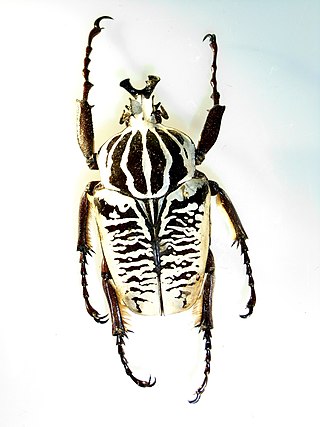
Goliathus albosignatus is a species of beetle of the family Scarabaeidae, described by Boheman in 1857. It is one of several species of Goliath beetles that inhabit Africa, but it is the only one exclusively found in subtropical sections of the continent.

Goliathus orientalis is a species of beetles belonging to the family Scarabaeidae.

Goliathus regius, the Royal Goliath beetle, is a species of beetles of the family Scarabaeidae.

Xylotrupes gideon, the brown rhinoceros beetle, is a species of large scarab beetle belonging to the subfamily Dynastinae.

Dynastes satanas, the Satanas beetle, is a species of beetle belonging to the family Scarabaeidae. The name is sometimes misspelled as "satanus".

The western Hercules beetle is a species of rhinoceros beetle that lives in Arizona, New Mexico and Utah in the United States and in parts of northern Mexico. This species is known for its grayish-white elytra, large size, and characteristic horn of the adult males.

Blaesia atra is a beetle of the family Scarabaeidae and subfamily Cetoniinae.

Sulcophanaeus imperator is a brightly colored species of dung beetle belonging to the family Scarabaeidae. This diurnal, coprophagous beetle is native to south-central South America and generally common. It is paracoprid, meaning that adults dig tunnels into the soil under the food source and move parts of the food source to a nest chamber where the eggs are laid.
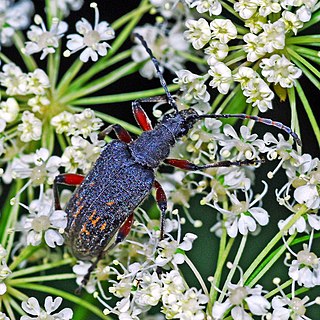
Evodinus clathratus is a species of beetles in the family Cerambycidae.

Catharsius pithecius, is a species of dung beetle found in India, Sri Lanka, Pakistan and China.
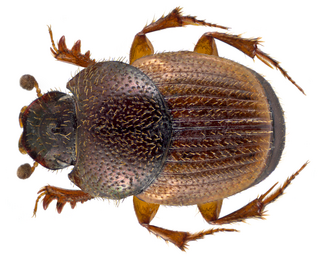
Onthophagus centricornis is a species of dung beetle found in India, Sri Lanka and Afghanistan. It is a small arboreal dung beetle inhabited in both dry and wet forests.
Onthophagus falsus, is a species of dung beetle found in India, Sri Lanka and Pakistan.
Sisyphus crispatus, is a species of dung beetle found in India, Sri Lanka and Pakistan.
Dynastes maya, the Maya white beetle, is a species of New World scarab beetles (Scarabaeidae). It has a distribution range in the Central American region, specifically in southern Mexico, Honduras, and Guatemala.


















